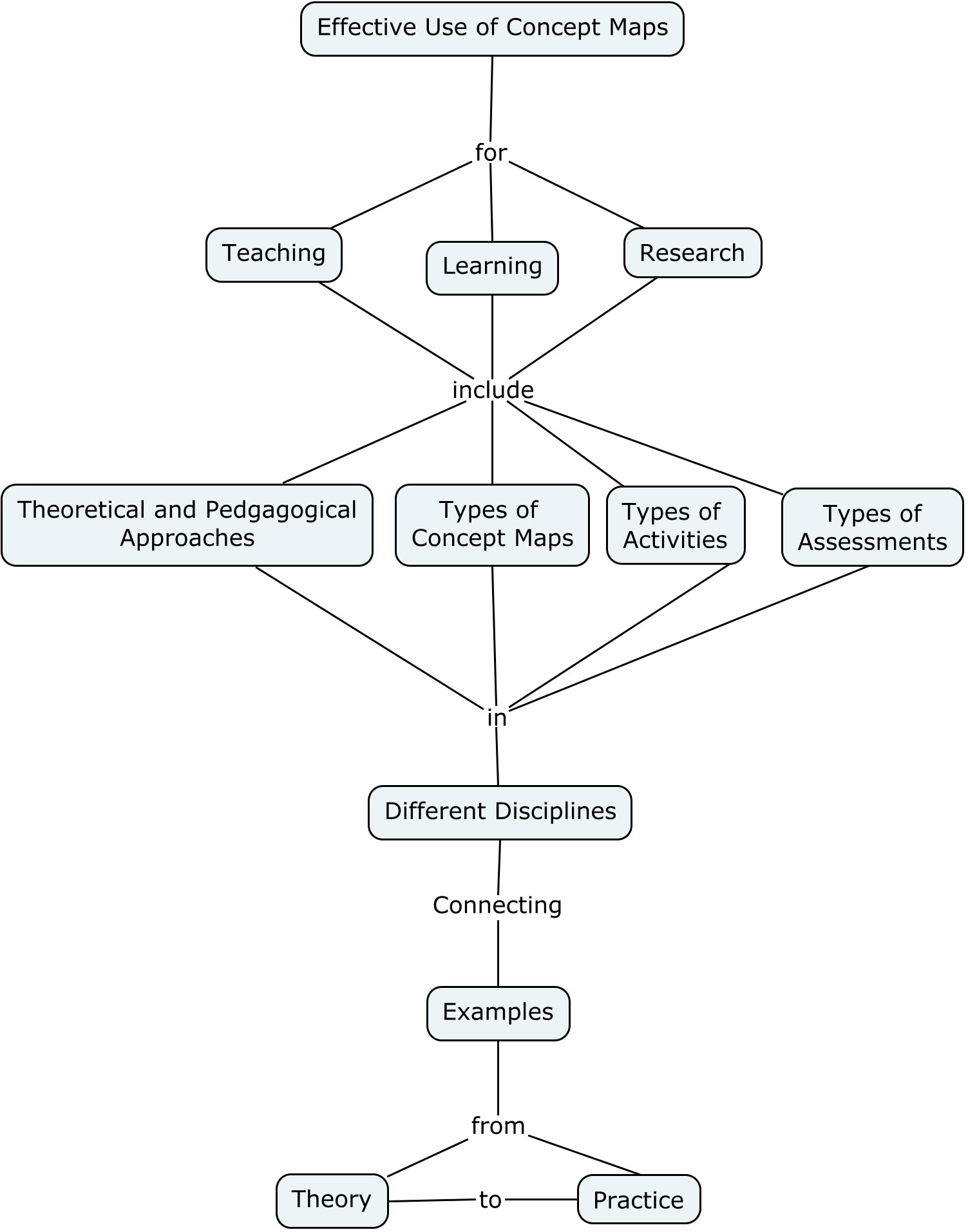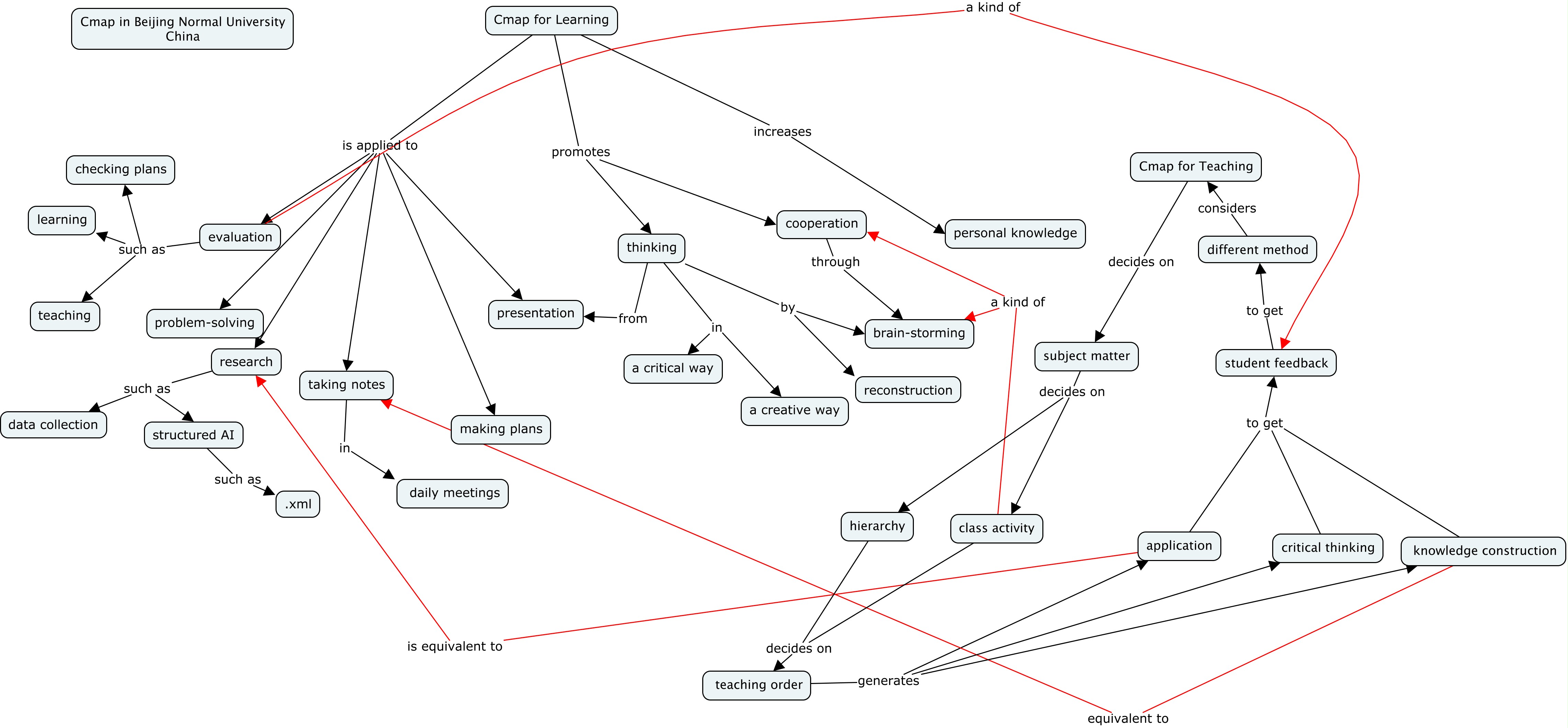按照Teach Less, Learn More课程体系的一般设计要求和《学会学习和思考》的设计原则,我们做了《教育和教育研究》的设计。
Effective Use of Concept Maps for Teaching, Learning, and Research
Dr. Simone C. O. Conceição, Professor, University of Wisconsin-Milwaukee

This module will introduce you to effective strategies for using concept maps for teaching, learning, and research. At the end of this module, you will will be able to use concept maps as an approach for teaching and learning in different disciplines; create a blueprint incorporating concept map as a learning strategy; identify ways for using concept maps as a research tool for data collection, analysis, and presentation; and develop a plan for using concept maps for conducting research.
This module will involve presentation of concepts and theories via lecture, group discussion, and individual and group practice using IHMC CmapTools Software.
This module will be taught in English. You will be expected to complete assignments in English.
It is expected that you will have some knowledge of the use of concept maps and skills on how to use IHMC CmapTools Software. Also, you will be expected to complete readings before attending sessions.
Module Outline

Day One
Introductions, Getting to Know Participants, Needs assessment, Scavenger Hunt, Pedagogical and Theoretical Approaches for Using Concept Maps, Types of Concept Maps, Learning strategies using concept maps
DAY Two
Learning strategies using concept maps in different disciplines
DAY Three
Teaching strategies using concept maps in different disciplines: activities
DAY Four
Teaching strategies using concept maps in different disciplines: assessments
DAY Five
Research strategies using concept maps: data collection and analysis
DAY Six
Research strategies using concept maps: data presentation
Learning Assessment
Students will be graded based on participation in course activities, course blueprint, module reflections, and final presentation.
References
Burke, J. G., O’Campo, P., Peak, G. L., Gielen, A. C., McDonnell, K. A., & Trochim, W. M. (2005). An introduction to concept mapping as a participatory public health research method. Qualitative Health Research, 15(10), 1392-1410.
Butler-Kisber, L., & Poldma, T. (2010). The Power of Visual Approaches in Qualitative Inquiry: The Use of Collage Making and Concept Mapping in Experiential Research. Journal of Research Practice, 6(2). Retrieved from http://jrp.icaap.org/index.php/jrp/article/view/197/196
Campbell, R., & Salem, D. A. (1999). Concept Mapping as a Feminist Research Method Examining the Community Response to Rape. Psychology of Women Quarterly, 23(1), 65-89.
Cañas, A. J., & Novak, J. D. (2006). Using concept maps to organize information for large-scale literature reviews and technical reports: two case studies.
Conceição, S. C. O., & Taylor, L. D. (2007). Using a constructivist approach with online concept maps: Relationship between theory and nursing education. Nursing Education Perspectives, 28(5), 268-75. National League for Nursing.
Conceição, S. C. O, Baldor, M. J. & Desnoyers, C. A. (2009). Factors influencing individual construction of knowledge in an online community of learning and inquiry using concept maps. In R. Marriott & P. Torres (Eds.) Handbook of Research on Collaborative Learning using Concept Mapping, 100-119. IGI Global.
Daley, B. J., Canas, A. J., & Stark, T. (2007). CmapTools: Integrating teaching, learning, and evaluation in online modules. New Directions for Adult and Continuing Education, 2007, 113, 37-47.
Daley, B. J., Conceição, S. C. O., Mina, L., Altman, B., Baldor, M.J., & Brown, J. (2010). Concept mapping: A strategy to support the development of practice, research, and theory within human resource development. Human Resource Development Review, XX(X), 1-28.
Hay, D. B. & Kinchin, E. M. (2006). Using concept maps to reveal conceptual typologies. Education & Training, 48 (2/3), 127-142.
Jackson, K. M., & Trochim, W. M. (2002). Concept mapping as an alternative approach for the analysis of open-ended survey responses. Organizational Research Methods, 5(4), 307-336.
Kinchin, I. M., Streatfield, D., & Hay, D. B. (2010). Using Concept Mapping to Enhance the Research Interview. International Journal of Qualitative Methods, 9(1).
Meagher-Stewart, D., Solberg, S. M., Warner, G., MacDonald, J., McPherson, C., & Seaman, P. (2012). Understanding the Role of Communities of Practice in Evidence-Informed Decision Making in Public Health. Qualitative Health Research, 20(10),1-17.
Morrison, D. (2006). Critical Thinking in a Collaborative Online Learning Environment. Advanced Technology for Learning, 3(4), 255-262.
Richardson, R. (2007). Using concept maps as a tool for cross-language relevance determination. (Order No. 3288675, Virginia Polytechnic Institute and State University). ProQuest Dissertations and Theses, 196. Retrieved from https://ezproxy.lib.uwm.edu/login?url=http://search.proquest.com/docview/304792723?accountid=15078. (304792723).
Trochim, W. K. Concept Mapping, available at http://www.socialresearchmethods.net/kb/conmap.htm
Trochim, W., & Kane, M. (2005). Concept mapping: an introduction to structured conceptualization in health care. International Journal for Quality in Health Care, 17(3), 187-191.
Wheeldon, J., & Faubert, J. (2009). Framing Experience: Concept Maps, Mind Maps, and Data Collection in Qualitative Research. International Journal of Qualitative Methods, 8(3).
Wheeldon, J. (2010). Mapping mixed methods research: Methods, measures, and meaning. Journal of Mixed Methods Research, 4(2), 87-102.
Wheeldon, J. (2011). Is a Picture Worth a Thousand Words? Using Mind Maps to Facilitate Participant Recall in Qualitative Research. Qualitative Report, 16(2), 509-522.